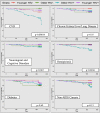Low incidence of advanced neurological burden but high incidence of age-related conditions that are dementia risk factors in aging people living with HIV: a data-linkage 10-year follow-up study
- PMID: 36508059
- PMCID: PMC10185650
- DOI: 10.1007/s13365-022-01104-0
Low incidence of advanced neurological burden but high incidence of age-related conditions that are dementia risk factors in aging people living with HIV: a data-linkage 10-year follow-up study
Abstract
Although increasing research is focusing on age-related comorbidities (ARC) among people living with HIV (PLHIV), no studies have concomitantly assessed non-HIV age-related neurological disorders (e.g., Alzheimer's dementia). A total of 254 PLHIV and 69 HIV-negative controls completed baseline medical history and cognitive testing. ARC data were collected from medical records over the subsequent 9-10 years and included all types of strokes, all types of dementia, mild cognitive impairment, Parkinson's disease, motor neuron disease (grouped into a non-HIV age-related neurological category), cardiovascular disease, chronic kidney disease, chronic liver disease, chronic lung disease, non-AIDS cancers, osteoporosis, and diabetes. Kaplan-Meier curves assessed differences in the incident rates (per 1000 person year) of groups of ARC as defined above and combined ARC (i.e., development of any of the ARC) among younger (baseline age < 50) and older (baseline age ≥ 50) PLHIV and younger and older controls. Cox-proportional hazard models assessed the individual and interaction effects of HIV status and chronological age, in addition to a range of demographic and clinical variables including historical and baseline HIV brain involvement on the risk of developing combined ARC. Older PLHIV had a higher incidence of cardiovascular disease, osteoporosis, and combined ARC compared to other groups (p < 0.05). Incident rate of non-HIV age-related neurological disorders was 2.3 [0.93, 4.79] per 1000 person year. While this incident rate was higher in older PLHIV (5.37 [1.97, 11.92]) than older HIV-negative participants (3.58 [0.18-17.67]), this was not significant. In multivariate analyses, HIV status and chronological age, but not their interaction, and smoking were associated with higher risk of combined ARC (p < 0.05). In analyses focusing on PLHIV, older age and taking abacavir/efavirenz/atazanavir/darunavir containing antiretroviral treatments at the time of diagnosis were associated with greater ARC (p < 0.05). Non-HIV age-related neurological disorders are uncommon in older PLHIV, where the majority were < 70 years of age at the end of follow-up. However, the greater burden of ARC among older PLHIV, most of which are established dementia risk factors, warrants the establishment of commensurate prevention strategies and greater attention to neurocognitive screening.
Keywords: Aging; Comorbidities; HIV; Incidence; Neurological disorders.
© 2022. The Author(s).
Conflict of interest statement
Bruce J. Brew received speaker honorarium from Janssen. Mark Bloch received funds for medical advisory boards and educational meetings from Gilead Sciences, Abbvie, Janssen, and ViiV Healthcare. He also received funding for research from Gilead Sciences, ViiV Healthcare, MSD, Abbvie, and GSK. All the other authors declare no conflict of interests.
Figures


Similar articles
-
Comorbid diseases and conditions in people with HIV in the UK.Curr Med Res Opin. 2022 Feb;38(2):277-285. doi: 10.1080/03007995.2021.2003671. Epub 2021 Nov 30. Curr Med Res Opin. 2022. PMID: 34761727
-
Incidence and risk factors regarding atherosclerotic cardiovascular disease in middle-aged and elderly people with HIV treated in Chongqing, China.AIDS Res Ther. 2024 Dec 19;21(1):92. doi: 10.1186/s12981-024-00684-7. AIDS Res Ther. 2024. PMID: 39702183 Free PMC article.
-
Trends and predictors of non-communicable disease multimorbidity among adults living with HIV and receiving antiretroviral therapy in Brazil.J Int AIDS Soc. 2019 Jan;22(1):e25233. doi: 10.1002/jia2.25233. J Int AIDS Soc. 2019. PMID: 30697950 Free PMC article.
-
Is There Any Evidence of Premature, Accentuated and Accelerated Aging Effects on Neurocognition in People Living with HIV? A Systematic Review.AIDS Behav. 2021 Mar;25(3):917-960. doi: 10.1007/s10461-020-03053-3. Epub 2020 Oct 6. AIDS Behav. 2021. PMID: 33025390 Free PMC article.
-
Prevalence and risk factors of cardiovascular disease among people living with HIV in the Asia-Pacific region: a systematic review.BMC Public Health. 2023 Mar 13;23(1):477. doi: 10.1186/s12889-023-15321-7. BMC Public Health. 2023. PMID: 36915099 Free PMC article.
Cited by
-
Nucleoside Reverse Transcriptase Inhibitor Exposure Is Associated with Lower Alzheimer's Disease Risk: A Retrospective Cohort Proof-of-Concept Study.Pharmaceuticals (Basel). 2024 Mar 22;17(4):408. doi: 10.3390/ph17040408. Pharmaceuticals (Basel). 2024. PMID: 38675371 Free PMC article.
-
Progress Note 2024: Curing HIV; Not in My Lifetime or Just Around the Corner?Pathog Immun. 2024 Mar 1;8(2):115-157. doi: 10.20411/pai.v8i2.665. eCollection 2023. Pathog Immun. 2024. PMID: 38455668 Free PMC article.
-
Central nervous system and neuropsychiatric disturbances in people living with HIV.Infez Med. 2023 Dec 1;31(4):488-494. doi: 10.53854/liim-3104-7. eCollection 2023. Infez Med. 2023. PMID: 38075411 Free PMC article. Review.
References
-
- Aung HL, Gates TM, Mao L, Brew BJ, Rourke SB, Cysique LA (2022) Abnormal cognitive aging in people with HIV: evidence from Data Integration between two countries’ cohort studies. AIDS 10:1097 - PubMed
-
- Aung HL, Kootar S, Gates TM, Brew BJ, Cysique LA. How all-type dementia risk factors and modifiable risk interventions may be relevant to the first-generation aging with HIV infection? Eur Geriatr Med. 2019;10:227–238. - PubMed
Publication types
MeSH terms
LinkOut - more resources
Full Text Sources
Medical

